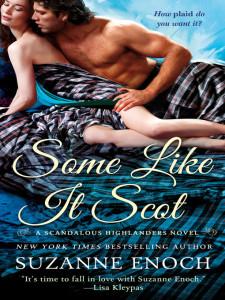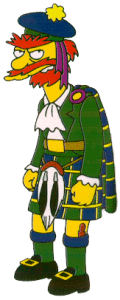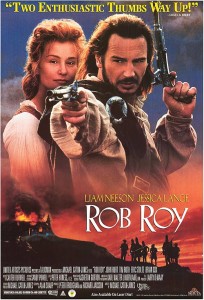Mon, 01/04/2016 - 6:03pm

 Recently I walked past a re-shelving cart and noticed a paperback romance called Some Like It Scot, with cover art depicting a heterosexual couple under-dressed for Scottish weather. According to the catalog record, the novel is part of a series called Scandalous Highlanders. Then scanning the shelves where we keep paperback romances at SPL, I realized that tartan-themed passion seems to be a really popular genre (I know next to nothing about romance novels, so this is all new to me): The Devil Wears Plaid, To Kiss a Kilted Warrior, Highland Rogue, and The Highland Dragon's Lady (among other titles) are all available as guilty pleasures at SPL. And over at GoodReads someone compiled a list of "Best Highland/Scotland Romance Novels" consisting of 449 titles. As my co-worker Ellen and I were talking bemusedly about the existence of Scottish/Highland love stories, she asked, "Why is this A Thing? Why Scottish romances? Why not Czech romances? Or Norwegian romances?" I didn't have an answer. And it's a fair question, especially if when you hear the word "Scotland," the first thing you think is "Groundskeeper Willie."
Recently I walked past a re-shelving cart and noticed a paperback romance called Some Like It Scot, with cover art depicting a heterosexual couple under-dressed for Scottish weather. According to the catalog record, the novel is part of a series called Scandalous Highlanders. Then scanning the shelves where we keep paperback romances at SPL, I realized that tartan-themed passion seems to be a really popular genre (I know next to nothing about romance novels, so this is all new to me): The Devil Wears Plaid, To Kiss a Kilted Warrior, Highland Rogue, and The Highland Dragon's Lady (among other titles) are all available as guilty pleasures at SPL. And over at GoodReads someone compiled a list of "Best Highland/Scotland Romance Novels" consisting of 449 titles. As my co-worker Ellen and I were talking bemusedly about the existence of Scottish/Highland love stories, she asked, "Why is this A Thing? Why Scottish romances? Why not Czech romances? Or Norwegian romances?" I didn't have an answer. And it's a fair question, especially if when you hear the word "Scotland," the first thing you think is "Groundskeeper Willie."
 I started thinking about it, mentally rummaging through what I remember from reading British history. Before the mid-eighteenth century, Scottish Highlanders were considered dangerous and uncivilized by most of the English-speaking world, including the inhabitants of Scottish towns and cities. But in the 1740s the British government enacted a series of laws that forced Highlanders to surrender their swords and outlawed traditional Highland culture, including the clan system of government and mutual obligation. Then much of the Highlands were depopulated when lords evicted tenant farmers to use their land for raising sheep. Once a people or a society formerly considered dangerous and living in a remote place is no longer a threat, they're easy to romanticize. In a blog post entitled "Hot for a Scot," Harlequin books editor Carly Silver wrote that the archaic image of Highland culture--a warrior culture in an untamed land--make Highland Scottish men "seem more foreign, and simultaneously, more desirable...the loner bad boys of the British Isles."
I started thinking about it, mentally rummaging through what I remember from reading British history. Before the mid-eighteenth century, Scottish Highlanders were considered dangerous and uncivilized by most of the English-speaking world, including the inhabitants of Scottish towns and cities. But in the 1740s the British government enacted a series of laws that forced Highlanders to surrender their swords and outlawed traditional Highland culture, including the clan system of government and mutual obligation. Then much of the Highlands were depopulated when lords evicted tenant farmers to use their land for raising sheep. Once a people or a society formerly considered dangerous and living in a remote place is no longer a threat, they're easy to romanticize. In a blog post entitled "Hot for a Scot," Harlequin books editor Carly Silver wrote that the archaic image of Highland culture--a warrior culture in an untamed land--make Highland Scottish men "seem more foreign, and simultaneously, more desirable...the loner bad boys of the British Isles."
Contemporary romance writers were by no means the first to tap into the appeal of the Scots in general and Highlanders in particular. That distinction probably belongs to the inventor of the historical novel, Walter Scott (1771-1832), who tapped into Scottish history and legend for the plots of his novels such as Rob Roy, The Bride of Lammermoor, and Waverly. He was one of the best-selling authors of his day, and composers and filmmakers adapted his work for the next century. The romantic of appeal of the Scottish past has also shaped folk music and even amateur athletics. So if you're someone who reads Scottish romances and is a little embarrassed by it, take heart: we're all entitled to guilty pleasures. And you're part of a long tradition. And for the record, there are Norwegian romances. Sort of.
Posted by Kevin.

Add new comment